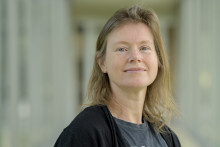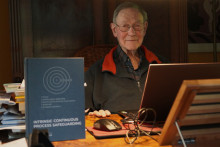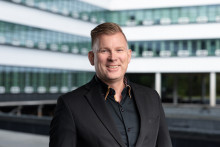Radio interviews, newspaper articles, few professors have drawn as much media attention in recent months as Kerensa Broersen. Not because of her field per se, but due to the budget cuts and reorganisation at her faculty. Like newly appointed dean Jeroen Cornelissen, she was initially slated for redundancy, only to rise like a phoenix from the ashes.
But Broersen would prefer not to dwell on that now. On 18 September, her oratie, the festive, official installation ceremony for professors, is on the agenda. ‘At first I had mixed feelings about it,’ Broersen admits. ‘It isn’t compulsory. But after talking to several people, I decided to do it anyway. For those around me, and for myself. It’s time to look ahead.’
Broersen is never idle. While she is still refining the content of her speech, she has just returned from a lecture in Liège on her stem-cell research. ‘And next week I’ll be in London for a conference.’
What many do not know is that Broersen originally trained as a dietitian. ‘I’ve always been interested in nutrition. But I found it even more fascinating to understand what happens after you eat, and how that affects how you feel. I just love difficult things,’ she grins. She is now a professor researching communication between the brain and the gut.
Vagus nerve
Broersen focuses on the body’s ‘second brain’: the gut. ‘The brain and gut communicate via, among other things, the nervus vagus, the nerve pathway of roughly a metre that runs like a motorway along your spine. In addition, every person carries about two kilos of bacteria in the gut. Through various processes, these exchange information — via the vagus nerve — with the brain, influencing each other in both directions.’
She continues: ‘We now know, for example, that Parkinson’s disease can be observed in the gut flora years before the classic symptoms appear in the brain. Clinical researcher Jolien Wolbert will be pursuing this further in our team. We also think this line of work can shed light on the role of the gut and microbiome in the onset and progression of brainstem tumours, autism, schizophrenia, and Alzheimer’s.’
Mini-organs
To investigate this properly, Broersen’s team works with stem cells. ‘These are generalist cells that have not yet ‘chosen’ a specialised function. We now know how to influence these cells so that they behave as if they were human gut, brain, or nervus vagus cells. In this way, we create mini-organs. You can run all sorts of studies with them, without needing human participants or animal experiments.’
‘The brain, the gut, and the vagus nerve each sit in different parts of the body, with their own unique conditions, such as acidity and mechanical forces. The signals exchanged between gut and brain also depend on specific chemical and biological factors that are not present in standard reaction vessels.’
She goes on: ‘We can make the cells ‘think’ they are, say, gut cells, but the challenge is reproducing the conditions of the abdominal cavity. And the same goes for the brain.’ With specialised lab-on-a-chip technology, thanks in part to the work of Professor Loes Segerink (of Biomedical Microdevices, ed.), we can now do that. By growing our mini-organs using this technology, we can, in part, mimic the anatomy and physiology of the human body.’
Much still unknown
‘There is still so much we don’t know, something I want to emphasise in my lecture. So far, we have mainly focused on the small intestine, but there is also the large intestine. Altogether, our intestines have a surface area about the size of a tennis court. Then there are differences in pH levels, enzymes, microbiota, the mucous layer… There is plenty to discover.’
Animation
What will her lecture be about? ‘Its Dutch title is De bezieling van het micro-orgaan, which translates as The animation of the mini-organ. I want to explore whether you can measure passion, motivation, love, and other drivers in the stem-cell-derived mini-organs we create. The circumstances in which a person eats also play a role: are you eating your sandwiches alone in a gloomy canteen, or cooking with friends and enjoying the evening together? That makes a big difference.’
Broersen’s strength lies in making information accessible. ‘I enjoy that. An inaugural lecture draws family, friends, acquaintances — half my running club will attend… People for whom this work isn’t daily fare. I want to present it as simply as possible for them. That’s why I’ll deliver it in Dutch. And anyone curious about what Barbapapa has to do with our mini-organs is warmly invited to come along.’
For Broersen, the appeal of her work lies in the blend of the technical and the biological, with clear societal impact. ‘We keep uncovering new facets of long-known diseases. That helps support the development of better treatments, and hopefully helps people live healthier lives.’




